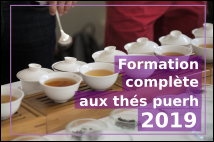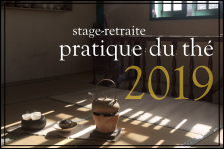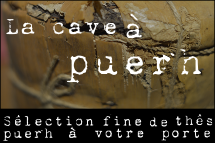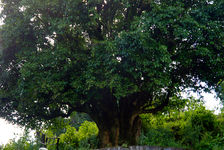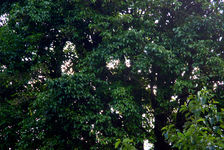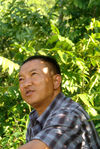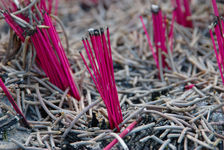 This page is not a real translation but just an automatic translation generated by computer of the original article, written in French language! Its not good... but better than nothing!
This page is not a real translation but just an automatic translation generated by computer of the original article, written in French language! Its not good... but better than nothing!Want to help us do diffuse puerh tea culture in english, by providing a better (or corrected) translation?
Please contact us!

What is the origin of tea? Where does this mysterious tree that now grows in over 50 countries around the world? How was it discovered, and when man began to drink he leaves? These are the questions that for thousands of years many tea lovers arise ... Ancient legends of the early writing about tea, tea plants through multi-millennia Yunnan, I propose a journey through time in search of original tea tree.
Myths and legends about the origin of tea ...
Shennong, the Emperor of 5 seeds ...
A Myth in China is very common to attribute the discovery of tea to Shennong (神农). Also known as "Emperor of the 5 seeds", or "the holy farmer" is a key figure in Chinese mythology who lived between 2737 and 2697 BC. It is ready to Shennong that the invention of agriculture, the hoe, the plow and the art of planting and cultivating the five basic food (hence its name Emperor of 5 seeds).
But it is also Shennong which is the cause of Chinese medicine, sampling and analyzing it on a considerable number of plants, including 360 listed in the "Shennong bencaojing" (神农 本草 经) the first treaty of Chinese Medicine . Probably write between 300 and 200 BC, this treaty would be the transcription of Shennong knowledge, transmitted orally for more than 2000 years. And tasting all kinds of plants all day long Shennong, which sometimes swallow dozens of toxic plants in a single day was regularly seriously addicted.
The story goes that one day of the year 2737 BC, Sehnnong after drinking a lot of toxic plants, would have infused the leaves and twigs of tea, or according to other versions would have chewed some fresh tea leaves. Thus he would have discovered the virtues of detoxifying tea, and that he would be back in Chinese medicine.
Another version of the legend attributes the discovery to chance. According to this last Emperor of 5 seeds drank quietly in the shade of a tree a bowl of water he had boiled. Suddenly a leaf from a nearby tea plant, transported by the wind came accidentally dropped into his cup, instantly changing the color of the water contained therein. Shennong who took a sip would have been struck by the incredible aroma that would be generated.
Bodhidharma, Zen meditation in the first tea ...
Another legend even more amazing and Tang Dynasty attributes the birth of tea to Bodhidharma (菩提 达摩) there there's 1500 years ago. Originally from India, the monk Bodhidharma said to have lived in China between the 5th and the 6th century, where it would come to bring the teaching of Buddha. Often regarded as the creator of the Chan school (禅), which became Zen in Japan, but also as the father of Shaolin Gung Fu.
Bodhidharma after crossing the Yangtze River in 527 would stop in the Temple of Mount Song in Henan. There still meditate nine years facing a wall which earned him the nickname "Brahmin contemplating his wall." Legend's After these nine years they would be asleep by accident. Upon awakening, Bodhidharma realizing the thing cut off his eyelids so that it can not happen again and threw to the ground.
In passing the same place a few years later, he would have discovered that two trees had driven there or he had abandoned his eyelids and he plucked a few leaves mechanically.
At the end of his life, nine years Bodhidharma go of his life meditating in front of a rock in a cave. It is said that after several years of meditation, a day when he began to feel tired, they would have the reflex chewing a few leaves that had previously picked up. He would have discovered that these sheets, which were actually tea leaves, gave the power to remain in a state of increased concentration of hunting boredom and fatigue and keep the mind awake.
Following this commençairent to eat the monks and to cultivate these precious tea leaves, to support them during their long periods of meditation.
Although the legend is very little credible link between consumption of tea by Buddhist monks, especially Zen, and early dissemination of tea in China is an irrefutable fact.
In a compilation of ancient texts Yan Feng (Feng Shi Wen Jian Ji) are found in this connection the following quotation: "The tea was a drink used to be assessed solely by the southerners, and that few people North drank. This changed during the period when Kaiyuan (712-756), when the monks Chan started to promote their religion. If piously engaged to intense and prolonged, requiring no food and sleep, Tea became their only source of energy. "
The first write about tea to the official history of Chinese tea
The origin of tea is a question that has always challenged many thinkers and cultural figures of tea to begin with Lu Yu (陆羽), the Chinese have high stage of God's tea.
Classic tea, first written about tea there are over 1200 years
Lu Yu, who lived in China there are over 1000 years probably has them more than anyone else influence what the tea Tea has become in this country and around the world. If he did not discover the tea itself has, by writing the first book accurate and complete to the tea culture of the time, largely initiated the rapid spread of the use of tea in China, and the entry tea in the Chinese dailies. This book written in the year 780, the famous Classic tea, which makes a point as comprehensive as possible on what is known at this time of growing tea, is intended as educational and teaches how to cultivate the art of tea that best prepare a cup of tea.
The first chapter of the bible of tea, is titled such as "seek the origin of tea". We learn from the pen of Lu Yu tea is a plant native to southern China, ranging in size from 60cm to nearly 4m depending on its location. Lu Yu says that in eastern Sichuan and western Hubei, there are a variety of gigantic trees, two people with outstretched arms are needed to embrace in the trunk and which one is countered to climb the branches to reach the leaves.
If this description is not without surprise the contemporary reader, more accustomed to seeing in the form of tea bushes maintained at breast height, like landscapes of majestic old trees still exist today in parts of Yunnan. In time, however, Lu Yu Yunnan, about whom he never refers, was not a region as China is today but a distressed area, the intersection of Burma, Laos and Viet Nam, inhabited by different ethnic groups and partially controlled by the Kingdom of Nanzao (founded two years after the birth of Lu Yu).





- 1.The classic of tea Lu Yu wrote in 780
- 2.Yunnan in the south east asia
- 3.Tea Tree taking the appearance of large bush in Yunnan today
- 4.Greater Tomorrow s tea in Yunnan
- 5.modern large scale plantation in Yunnan
Similarly one can relativize largely categorical assertions of ancient writers concerning the location of a particular type of tea. For Lu Yu tea plants take the appearance of real trees in Sichuan while that for Shen Shen Kuo Cunzhong alias (in Meng Xi Bi Tan) Sichuan plants are herbaceous shrubs only when, according to Shen Kuo, those of Jian'an would all be real trees. Seen in the size of these regions, the same difficulty to get around today, one can imagine the conditions there are over 2000 years and therefore the partial knowledge of these regions by the authors of the time . It is thus more likely to believe that tea plants of different sizes and forms coexisted in different regions of present day China.
Lu Yu also invites us to observe the composition of Chinese tea idéograme (Cha 茶) which he said involves characterizing the etymological origin as an herb tea, a tree or shrub between. In most cases according to Lu Yu, tea plants that grow naturally in their wild habitats are in better conditions than those grown in gardens, especially where tea can nest in the shade of a forest of trees greater .


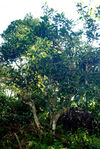
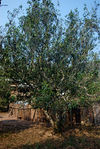
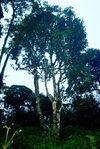
- 1. Tea Tree in the heart of the forest (Shan Jinuo)
- 2. Tea Tree in the heart of the forest (Wu Yi)
- 3. Grand old tea tree (Jinuo Shan, Xishuangbanna)
- 4. Grand old tea tree (Pu'er)
- 5. Grand old tea tree (Lao Banzhang, Xishuangbanna)
One can infer from these few lines of Lu Yu the landscape could have seen that there are over 1200 years during his various explorations in search of tea: The wild tea plants of nearly 4m with large trunks evolving core drills Sichuan, but also crops domesticated by man in which could be large trees and bushes to just over half a meter.
This first book on tea also provides insights into a number of knowledge regarding the understanding and mastery that man could have on the cultivation of the tea plant it there's 1200 years. Lu Yu, who began by stating that the methods of cultivation of the tea plant are similar to those of melon, with the exception of the period of growth that reached three years for the tea, then different characters is necessary for the production of tea quality, thereby addressing the various aspects of tea cultivation. The soil first, that to produce a quality tea must have a floor covered with rocks eroded, where a ground for Lu Yu gravieux produce a medium quality tea and tea clay soil of inferior quality. Similarly, the tea should ideally grow on a sunny slope of the mountain, to the shelter of larger trees.
But mastering the cultivation of tea is not limited to understanding the environment, and contemporary of Lu Yu already brought great importance to crop conditions and especially good time to picking tea, depending not only climatic conditions as well as moon phases.
Following Lu Yu many scholars have written about the tea, gradually forming Chinese tea culture, affecting both considerations on the cultivation and harvesting trees, but the art of brewing tea leaves , through all stages of manufacture of these sheets.
Among these authors, a number have studied the origin of tea, including the reinterpretation of ancient writing, or the etymology of the word tea. If the character tea as we write today in Chinese (茶 Cha) appears only during the Tang Dynasty, it is separated from a common root very close You (荼) which may suggest that this was originally the same word, denoting potentially one plant tea which takes its origin.
Among the ancient texts there are however a number of authors who warn about the confusion between You and Cha , and refute the idea that any text referring to the plant formerly known as "you" would refer to tea. Wang Mao is in the twelfth century in particular its "trivia" (Ke Ye Cong Shu) that although it is commonly accepted that the ancestors named "you" was what is now called cha (tea), the argument is actually a category of vegetation does not cover a particular plant but many varieties. The only variety of you which would clearly indicate the current tea was named -jia you , and the authors would have spent for Wang Mao not make clear the distinction between different plant species that is analogous. As an example the passage of an author site "Classic of Poetry" (between the 7th and the 10th century BC) where it says: "It's not fair to describe the" you "as bitter? It tastes sweet like a shepherd's bag ". Wang Mao for this passage does not refer to tea as could be written but in a kind of bitter lettuce near the thistle.
From wild tea tree carved by the hand of man, a slow domestication
These ancient writings are also very informative about how when man will gradually domesticated tea, originally wild, to do what we know today. The tea was especially long considered by the ancients as a botanical species specific and impossible to transplant, when unable to be grown from seed. It is this character that is attributed to the tea that comes from the ancient custom of offering tea at the wedding, symbolizing the loyalty between the future couple.
The man, however, gradually passed this ancient belief, which in the words already in Chen Shi Guang Yuan Shi Jiao "was clearly based on hearsay", and to avoid changes caused by natural reproduction of the tea plant It increasingly gained control of cloning. If the tea cuttings, particularly sensitive, is very recent and is typically practiced for barely a century, an older method was used long before: the layering.
A branch of the tea plant was then gradually forced to bend and into the ground at some distance from the tree it was derived. After a certain time during which the branch has penetrated into the soil began to form roots, the link with the original tree is cut, and a new tree starts growing at the location or branch was severed.
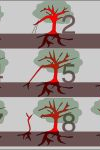
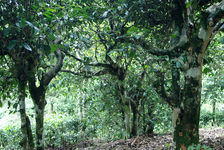
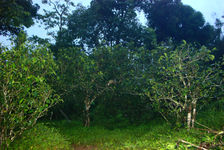

- 1. Principle of Layering
- 2. Tea Garden in old Nanuo, Xishuangbanna
- 3. Tea Garden in old Banzhang, Xishuangbanna
- 4. Tea Garden in old Puerh
But the master of the tea plant is not limited to reproduction, and it is several thousand years of experience and empirical knowledge about the particular size, environment and species selection, that man will gradually carved this wild tree for premium tea that can sometimes drink today. By observing the oldest tea trees that have survived to us, especially in Yunnan where this is the best concentrations of tea plants millennia, we are able to weigh the long process of domestication by man of tea.
I do not speak of course of mutations associated with modern agricultural practices, cultivar selection and cloning of increased large-scale processing of whole sections of forest in intensive farming, use of fertilizers and chemical pesticides or pseudo-natural, but to practices dating back thousands of years ago and whose tea today stems. Just look a wild tea tree, to touch the leaves, to drink tea to realize the path that was traveled from domesticated trees, even it there's 1000 years ago. Luckily a number of ancient tea trees in Yunnan have perdurés up today and allowing us to sample the flavor of another time.
This is first of wild tea plants that are still found in some remote forests of Yunnan, especially in areas of Pu'er and Lincang. Tea to its original state, it is often majestic trees over 10 meters high and as young as several thousand years that grow naturally in the heart of the forests. The tea they produce is unique, whether by its aromas, its character or the energy that comes out. Grown without human intervention are met with a number of sub-varieties by region, producing distinct aromas. There are however some permanence in general, especially when they are young and very fresh touches of citrus can remember the lemon or grapefruit, and a peculiar evolution over time, developing into something much deeper , bitter, sometimes almost smoked.
I propose to illustrate this particular of a tea made of wild tea tree buds of the year. Also be derived from wild tea this tea is doubly unusual, not only because it is a pure bud, and therefore contains no leaves more developed, but mainly because it was not shaped like a traditional puerh (Pu Er tea) which buds, like a white tea, so summers were carefully dried in order to maintain their appearance and stay as close to that found on the tree.
 Chargement du thé...
Chargement du thé...Other teas more standards-compliant puerh (Pu Er tea) however, are also produced from leaves of wild trees. Among them a famous tea mountain Da Xue area Mengku (cang) and produced by Shuangjiang Mengku. The tea plants are derived from the pancake which are large wild tea plants growing in a remote area of the forest in the heart of the mountain Da Xue. The story of tea began in 2001 when it was first produced by Shuangjiang Mengku for Purlple Cane, a Malaysian seller with a very famous and important place of tea cultivation in Malaysia.
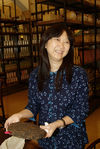
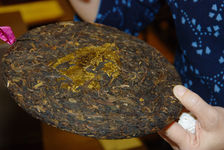
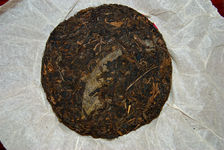
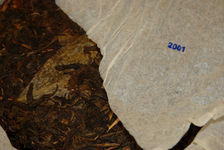
- 1. Camellia Siow, with the first wafer Purple Cane Tea Wild (2001)
- 3. 2001 Year of the cake Purple Cane Tea wild Mengku
- 4. 2001 Year of the cake of wild Mengku Purple Cane Tea
Besides the nature and origin of the leaves, the cake ordered and thought by Purple Cane is unusual in several respects. Its format first, 500g, where a conventional cake weighs 357g more generally (or 400g) thought for the long-term storage, but also the use of a large sheet of wild tea tree as a Nei Piao. Started in 2001 and this cake will be produced annually and sold exclusively by Purple Cane in Malaya between 2001 and 2007.
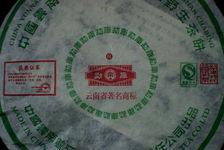
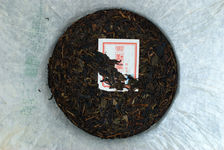
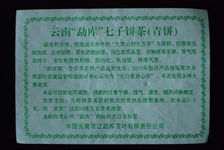
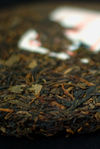
- 1. Da Xue Shan Shuangjiang Mengku Yeshan Chabing 2006
- 4. Da Xue Shan Shuangjiang Mengku Yeshan Chabing 2006
In 2006 the booming puerh (Pu Er tea) and seeing the success of this cake, Shuangjiang Mengku decides to go out the same tea on his own account and sells a 400g version of its name and with its own package under the reference "Da Xue Shan Yeshan Chabing "(tea cake wild mountain Da Xue), which is sure to displease Purple Cane orders that will stop the next year.
 Chargement du thé...
Chargement du thé...In 2010, four years after this production, Shuangjiang Mengku reiterates the urgent thing in a new vintage of its wild tea Da Xue, taking this time to the same original design of Purple Cane, a slab of 500g the surface of which is included a large sheet of wild tea tree in which the producer, however, added his own Nei Piao.
 Chargement du thé...
Chargement du thé...Produces the same year as this Mengku cake, another cake after wild tea produced by Lan Chun Ting and presented in the article on this producer (see Lan Ting Chun, excellence méconue Yong De ) is noteworthy. Although both sold as coming from the mountain Da Xue, Lincang area, these two discs do not come from the same mountain, two mountains bearing the same name, in fact, to Lincang. While that of the cake comes Suangjiang Mengku of Da Xue Shan Region Mengku, that produced by Lan Ting Chun comes from Da Xue Shan area of Yong De
 Chargement du thé...
Chargement du thé...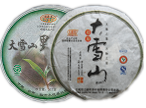
comparatif
Wild Trees Lan Ting Chun vs. 2010. Wild trees Shuangjiang Mengku 2010
If these two discs are from the same region, Lincang, and are advertised as coming from the mountain Da Shue, (大雪山), it is however not the same mountain. The cake comes Shuangjiang Mengku effect of Da Shan Shue Mengku, that while that produced by Lan Ting Chun comes from Da Shan Shue of Yongde in a neighboring district.
The surface of these wafers has very nice interweaving of leaves. , Bringing to his nose, the cake produced by Lan Ting Chun lets out a more intense flavor, round, fruity and deep, where the cake Mengku generates only little odor. To the eye immediately notice major differences. The cake Yongde (Lan Ting Chun) is indeed seen as much more colorful than his sister Mengku: One notices in particular a high proportion of yellow buds, typical of some wild tea plants, where the cake Mengku seems duller, Green and united.
At the infusion liqueurs are very close. If both are very pure and bright, that of Lan Ting Chun however, has a very slight turbidity against its competitor.
The scent of these patties perfectly illustrates their visual aspects. The tea produced by Lan Ting Chun is more colorful, floral, bright and clear, where the scent of tea Mengku are deaf, spicy and silky. Taste, although both teas are clearly the same range, we find that presaged the smell, with a tea Lan Ting Chun says that light and fruity, with hints of citrus clear that while the of Mengku appears as thorough and sober with aromas and spicy significantly heavier.
As the infusions, the taste in the mouth tends to get closer and reveals a common basis for these two teas. In the aftertaste remains, however, the characters proper to each, fruity and lemony tea for Lan Ting Chun, spicy and peppery for tea Shuangliang Mengku. Note also the hui gan tea Lan Chun Ting much more intense and persistent, and the cake Mengku, approaching a character more than what we normally expect from a good puerh (Pu Er tea) obtained from trees of old plantations .
Such wild teas, however, remain rare in the market, particularly because of the difficulties and risks of collection, requiring up fo the top of very tall trees often devoid of branches on the first meters. In addition the collection of these trees, often located in natural parks, is now strictly controlled (see prohibited in most cases) to avoid abuses as we could see during the high soaring price of puerh (Pu Er tea) where trees have such summers sawn to loot the leaves more easily. Finally flavors such wild trees are unique and are moving away from the current quality standards puerh, which will generally prefer tea from the so called old plantations of trees.
In recent summers have generally planted and maintained it there's between a hundred and a thousand years by the various ethnic groups who inhabited the mountains of Yunnan today, including Pu which descend the current Bulang. Man-planted from seed, or more rarely marcotés, these trees typically grouped in gardens are the result of a gradual transformation of wild tea tree to increased quality of the tea they produce. This mutation, which began there are over 2000 years is very slow and gradual, there are still today among the oldest trees in a number of trees called transitive, located halfway between the truly wild tea tree and old tea plantation.
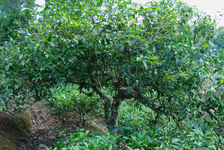
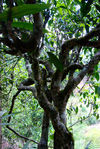
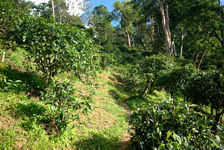
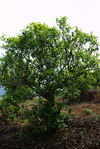
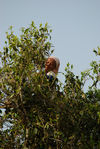
- 1. Trees old plantation (Nanuo Shan, Xishuangbanna)
- 3. Trees old plantation (Jinuo Shan, Xishuangbanna)
- 4. Trees old plantation (Bing Dai, Mengku, Lincang)
These old gardens are also a reflection of ancient farming methods, close and friendly nature. The tea gardens were often well integrated into the hearts of forests to enjoy the richness of the soil and the natural biodiversity of the forest, but also the shade of large trees and accumulation of fog they allow and is particularly beneficial to tea trees.
As in the past the natural balance of the environment was respected have also left its development to trees as they needed it, in places of over-exploited or improperly pruned as seen in increasingly common today. Often forgotten for several hundred years, during which the people who are behind sometimes disappeared or migrated, these trees are often richer for the wonderful setting in which they occur and are now producing some of the best teas they are.
However, although unfortunately many of these old gardens have disappeared, replaced by more profitable crops or have been completely massacred, including the destruction of forests and the environment in which they were part of the intensive cultivation of tea or other more profitable agricultural products between the ancient tea trees, or the misuse of fertilizers, pesticides or chemical herbicides.
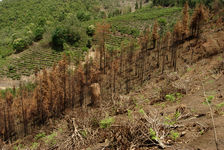
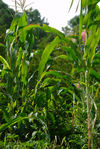
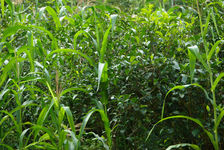
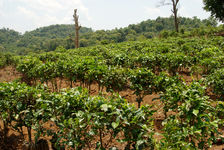
- 1. Picking tea plants seen in the more profitable crops to Nanuo
- 2. Culture and alternating corn tea Yong De, Lincang
- 4. Cup large trees and weeding soil Bulang
There are still remaining among the gardens, 199 local species of tea plants, including 153 born of sexual propagation, which are generally grouped around the term "high tea leaves from Yunnan". True legacy of the past, that the forests will contain Yunann yet far beyond local varieties, we references to the origins of tea and as we shall see are probably the most direct descendants of the first tea trees that were born .
Yunnan, looking for the pot of tea first?
There is near unanimity in the scientific community that, before being gradually introduced in over 50 countries, tea would derive its origin in a zone between the north-eastern India, southern Burma , Tibet and the current Chinese regions of Yunnan and Sichuan. Biologists have long considered the hypothesis of a double origin, and a cross, but recent research investigation, including genetic, confirmed a single origin of the tea plant. Gold points suggest that the first tea plants have emerged, there are quite a few thousand Annes this in the area now called Yunnan.
Out of the shadows recently with the popularity of tea puerh, Yunnan was long ignored in the history of tea, whether Chinese or international level. Yunnan is actually being incorporated as a province of China in 1274, the region is naturally absent, as we mentioned previously, first of all write with Lu Yu is the initiator. It was only in 1795 that we begin in China to recognize the value of the teas of Yunnan where tea Wu Yi is high at more Chinese teas being declared imperial tea, thus starting the famous tea route linking the village of Wu Yi in Beijing to transport these precious leaves to the quoted prohibited.
According to some historical writing, however, have a Yunnan tea history for over 2000 years. More are believed to Pu, Bulang ancestors who inhabited the region, have begun to plant and domesticate wild tea tree from the Shang Dynasty is from 1600 to 1050 BC, more than 1500 years before the famous Classic Tea by Lu Yu Various researchers in Yunnan and went in search of the origins of tea. Between 1953 and 1991 and was discovered during Lan Cang River (Mekong) a number of ancient trees. The famous "King of tea" of Nanuo, planted by man it there's about 800 years and often thought, wrongly as we shall see later, as the oldest tea tree planted by the hand of man, but also a transitive tree of a thousand years to Bangwei (邦 崴), both located in the region of Lan Cang (澜沧 县) in Pu'er.
Oldest yet they found a wild tree of 1700 years Bada, and again in the region of Pu'er an incredible wild tree of 2700 years Qianjia Zhai (千 家寨) (region of Yuan Zhen (镇沅 县)) whose trunk diameter reached 1.20 meters. But the quest of the first tea plants do not stop there, and take us to Lincang and specifically in the area of Qing Feng a tree or even more astonishing is waiting for us and we referrals there are over 3000 years ago .. .
A trees 3200 years beyond the legend
We are Lincang, Xian Feng in Qing (凤庆) which houses more than 3700 hectares of wild trees and transitive, and more specifically in the sub region Xiao Zhen Wan (小 湾镇). Access to the group of village of Jin Xiu cun (锦绣 村), then the village of Xiang Qing Zhu (香 竹 箐), is not always easy far from it. Dry weather and if the dirt road that provides access to the village is not cut it takes a few hours on a motorcycle. However, it is common, especially after each rain, the road becomes a genuine field of mud almost impassable.
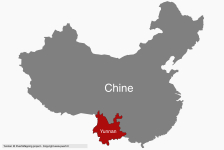
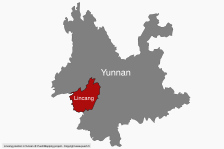
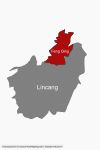
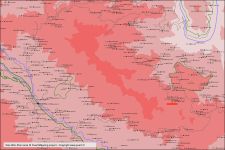
- 1. Location of Yunnan in China
- 2. Location of Lincang in Yunnan
- 3. Location of Xian Feng in Qing Lincang
- 4. Detailed map around Xiao Wan Zhen
although located directly east of the capital of Qing Feng, a mountain exceeding 2600m bar separates Jin Xiu Qing Feng Cun. The shortest path when the road is permitted to bypass the mountain from the south-east, at the mountain Shen Miao (神庙 山) where a pass at 2400 meter to switch to the other flank. Another way, beautiful but much longer is through the north east until you see the Lan Cang River Valley (Mekong), then along the mountainside until Xiang Qing Zhu, located at 2200 meters altitude.
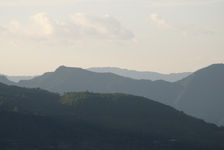
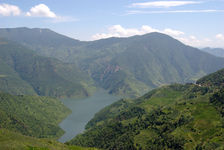
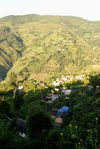
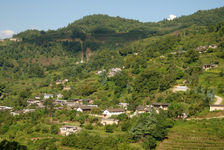
- 1. Early morning on the way to Zhu Qing Xiang
- 2. The Mekong to allentours Xiao Wan Zhen
- 3. Arrival at the village of Xiang Qing Zhu
- 4. Arrival at the village of Xiang Qing Zhu
This way, although difficult and challenging is beautiful, commands respect and truly gives the impression that borrows from entering another world, a sacred space where access is deserved. Passing a blank at the other, between Lu Bao Zhai (芦 宝 寨) and Li Xiao Zhong Shan Zhai (小 中山 里 寨) we discover suddenly below the majestic Lan Cang. Better known in French as the Mekong, whose name means "mother of all rivers", this mythical river that is known as Viet Nam "River of Nine Dragons" has its source in the Himalayan heights, before crossing through China, Laos, Burma, Cambodia and Vietnam. Now it is in the bed of the river found the tea trees older they are.
The mountain on the flank of which the small village of Xiang Qing Zhu is perched is particularly steep. Only a few miles as the crow flies separate its summit, at about 2700m and the river Lan Cang 1700m below. Near the top, and surrounded by forest atmosphere Xiang Qing Zhu is particularly peaceful. The village bathed in almost perfect silence exudes an atmosphere of harmony and isolation.
Just minutes from the village is a large modern ecological tea garden. Planted in terraces cut at breast height, this garden may at first be mistaken for an intensive modern plantation. Observing the trees more closely, however, we notice the quality and respect for planting: trees vigorous and bushy harvested sparingly, not weeded soil, no fertilizer, but also a rich and varied surrounding vegetation, in which one crosses in passage of goats and some chickens. In total nearly 120 acres of ecological gardens belonging to 200 families were planted in 2004 around the village, with support from the government.
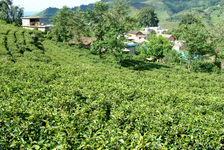
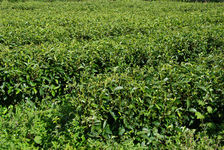
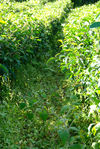
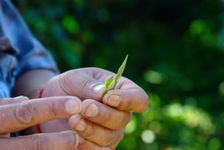
- 1. New Gardens ecological Qing Zhu Xiang
- 3. weedy Soils in new gardens of Qing Xiang Zhu
- 4. Young freshly picked bud Zhu Xiang Qing
driveway then a staircase of boulders eroded hill climbs and crosses between the tea plants, giving the place something solemn. Climbing the stairs in the sun, they seem to told us that the places where they lead us is not a vulgar but the meadow is approached something great, sacred. The stone path crosses, turning several times between the tea bushes. Gradually the young tea trees are scarce, and give way to wild vegetation consisting of tall trees of different species in the heart of which we cross some tea tanto several hundred years old.
Then the last steps leading to the meadow we promised. In its center a tea tree, huge and majestic dominates us. Facing him is immediately feel its power, something that inspires wisdom, peace, time seems to distort the realities and puts our worldview. Suddenly the past few decades on this earth seem a handful of seconds, something trivial and insignificant as a gesture of incest, against this plant and be quiet, which since at least 3200 years, observed the mountain. The size of the tree is impressive and requires a certain distance to be able to wrap my head. By approaching it changes to landscape, covers the field of vision to become that scary while. Gradually as one approaches its trunk, the sun disappears, only the penumbra. Particularly imposing its the diameter of the trunk approaches 2 meters, a circumference of more than 5 meters.
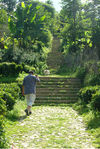
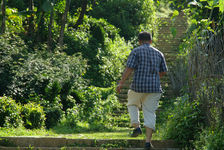
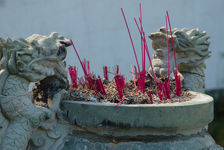
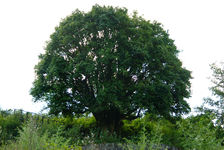
- 1. On the way more old tea tree in the world
- 3. Sticks of incense near the oldest tea tree in the world
- 4. The oldest tea tree in the world of 3200 years old
leaving his eyes slide along the branches of this tree is as fascinating as its past the moment that seems to reflect the past of a living being born there are over 3000 years one seed of tea. But can we really conceive of a being 3200 years, or even the places where we are there there's 3200 years of that? Can you imagine the world as long back and the men who were there are over 3000 years where we just put one foot?
Different people have studied this unique tree. According to studies it apparently between 3200 years (Professor Wang Guang Xhi) and 3500 years (Da Sen Zheng Zhi Lin Si), more than 1000 years before the cult book of Lu Yu, becoming by far the oldest tree Tea as we know it. The altitude at which it is also varies between 2100m and 2400m sources, my own GPS measurement referring 2260m.
But that's not all, and this tree is hidden in him something more surprising still. Already is, a tea tree 3200 years back over 1000 years before the first writing on the subject, and tells a lot more than what many legends about the origin of tea did not dare move. But what this tree tells us even more upsetting is that it is not a wild tea tree but a tree crop, planted by hand so it there's the man for 3200 years.
If found in a number of Yunnan wild tea transitive or a thousand years, tea plantation older usually have between 800 and 1000 years and are particularly rare, and such a tea tree planted by man there are over 3000 years is something unique, which references the beginnings of tea cultivation much further than we thought before. More than any other writing that is a priceless record of the origins of tea and the relationship of man to this plant.
Follows that it is more than 3000 years that man has not only discovered tea, but he has done the long way of domestication of this wild plant to grow and appreciate the leaves. But we know little about those who inhabited the area 3,000 years there's there, and were perhaps the first humans to discover the flavor of tea. What is certain is that besides the official history of China, with a history of nearly 5000 years is often cited as being the oldest continuous civilization, and next to the tea culture as History and the restraint it appears in the books, there was a culture much older around the tea leaves. And this history, dating back long before the empire of China would spread to Yunnan, is not to be found in the remains of Chinese culture, but more in the culture of ethnic groups for thousands of years live in Yunnan, and then discovered the domesticated wild tea tree and planted the first tea garden.
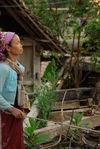
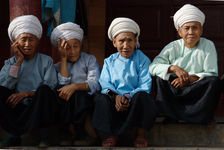
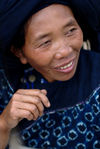

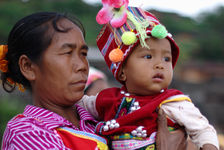
- 1. Woman to Bulang Bulang Shan, Xishuangbanna
- 2. Woman to Bulang Shuangjiang, Lincang
- 4. Woman Wa Shuangjiang, Lincang
- 5. Women and Wa her child to Shuangjiang, Lincang
probably the origin of tea there including Pu, which descended by some experts with current Blang ethnic Wa and De'ang, and we know the current live there there's Yunnan more than 2000 years. Attributed to particular Bulang who come down among the oldest tea garden of Yunnan, as we can see the mountain Bulang where many gardens were planted it there's between 500 to 1000 years ago.
Still others try to go back further into the origin of tea up to the tertiary era. Based on a fossil discovered in 1978 in the mountains of Mangxian Jinggu in Pu'er, which is estimated to have over 35 million years and that we attribute to form a large magnolia leaves, and on the assumption that descend from the tea plant in Magnolia large sheet, they see the trace of the origin of tea dating back more than 35 million years ago. If this fact was widely picked up and taken to account without verifying the sources, especially to promote the region Jinggu suddenly renamed puerh (Pu Er tea) the cradle, it is nevertheless emmètre a number of reserves on filiation possible between this fossil and tea to today.
aromas of another time
drip the aroma of the leaves of this tree multi-millennial Qing Feng is the dream of many tea lovers. However this is not a dream given to all the world, and few people have them that privilege. In 2007 six pancakes 499 grams of this tree were produced by Fengqing Cha Chang (belonging to the group Dianhong) and sold at auction in Shenzhen during the "International Cultural Industry Fair" with a reserve price of 300,000 RMB () per wafer.
The famous tea expert Vesper Chan, whom I recently wrote an article, could also have access to more or less legally leaves of this tree and would have produced a few rare slabs between 2002 and 2006, mostly auctioned for hundreds of thousands of RMB cake (See Article Vesper Chan, the story of a great man of Chinese tea ).
The tree, under the control of the group Dianhong and whose protection has cost RMB 1800000, does not operate apart from these few cakes. Surrounded by a high wall, access to the area is controlled to prevent the flight leaves, or any damage and few people could enjoy the aroma of tea.
The dean of tea trees is not the only ancient tree to grow on the exceptional terroir of Xiang Qing Zhu. In addition to the recent large ecological garden mentioned above there are about 500 trees over 1000 years, producing about 5 tons of tea every spring, and which it is possible to get the leaves.
If these trees do not have the incredible scale of the Dean of tea bushes, trees that remains outstanding part of the oldest tea plants on the planet. Forgotten for a long time their trunk is particularly well developed and they reach several meters high making them particularly difficult harvest.
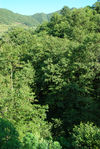
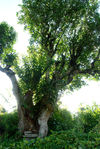
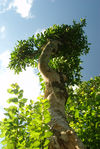
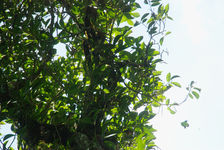
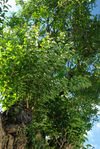
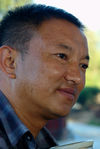
- 1. Beautiful setting local Xiang Qing Zhu
- 2. Millennium Tree local Qing Zhu Xiang
- 4. Millennium Tree local Qing Zhu Xiang
- 5. new tree growing on the trunk of an ancient tree Xiang Qing Zhu
- 6. Li Yu Lu, producer and head of the village of Xiang Qing Zhu
context in which they operate is it a rare richness. Perched outside any pollution at an altitude between 2000m and 2300m, they grow in the forest and clearings surrounding Xiang Zhu Qing, in a totally natural environment, not exploited by agriculture, and enjoying a very high biodiversity. These trees spaced sufficiently from one another grow in different forest plots belonging to different families in the village.
The village leader Li Lu Yu (李玉禄), collected in recent years these precious leaves, he buys the various families who own the trees and from which he produced several exceptional teas. Among them a puerh (Pu Er tea) made exclusively in ancient trees which I tasted the 2011 production for you.
 Chargement du thé...
Chargement du thé...
